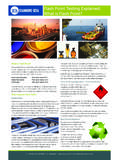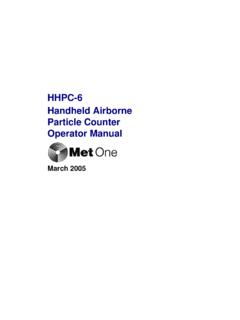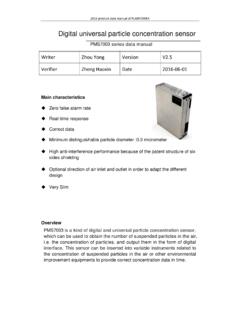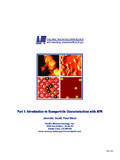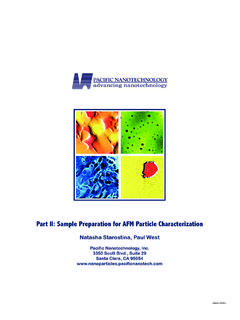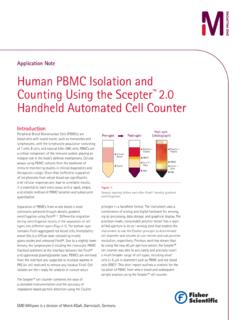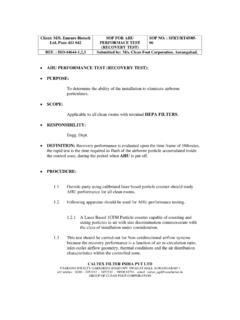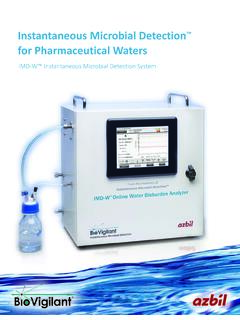Transcription of New revisions to IP 565 for Particle Counting in Jet Fuels ...
1 E: T: +44 (0)1932 575000 F: +44 (0)1932 568363 W: PARTICULATE IN JET Fuels WHY IS MEASUREMENT SO IMPORTANT? The issue of particulate contamination in Jet fuel has long been recognised for its associated problems affecting the fuel economy of aircrafts and causing maintenance down time issues. The appearance of particulate material can affect fuel lines and filters which subsequently block the flow of fuel to the engine, it can also cause fuel injection system problems reducing combustion efficiencies. Particulate measurement is an established means of monitoring quality control and product release and is classified by Particle size. Laser obscuration has become an established method of measuring the particulate contamination in Fuels worldwide.
2 The Energy Institute test method IP 565 for aviation turbine fuel is referenced in the DEF STAN 91-91 fuel Specification. The ASTM test method D7619 for middle distillate Fuels (which includes aviation turbine Fuels ) is also included in the D975 diesel specification for quality control purposes. LASER Particle COUNT THE PREFERRED TEST FOR SAMPLE DIAGNOSIS DETERMINING THE LIMITS Determining the limits that should be applied to laser obscuration Particle Counting test methods has historically proved difficult. The wide variation of the density of particulates precludes an accurate correlation between the established gravimetric limits and laser obscuration Particle counts. A further complication is that laser obscuration methods do not easily differentiate between particulates and dispersed water (free water droplets).
3 Laser obscuration based Particle Counting methods have a number of advantages over the traditional gravimetric method; these include short test times, simple operation and immediate results which indicate Particle size and distribution. Laser Particle Counting uses the light emitted by a laser to illuminate a cell through which the sample is passed. particles present in the sample cast a shadow onto the sensor within the cell, and as the Particle passes across the cell the voltage output of the sensor drops. The voltage drop of the cell is proportional to the Particle size and the size of the Particle is calculated based on this principle. The availability of reliable automatic Particle Counting apparatus and test methods, including AvCount and IP 565, has made these test methods a viable option for specification purposes.
4 The improved precision of these methods has resulted in some standardisation authorities stating their intention to replace gravimetric tests with laser obscuration Particle Counting tests at the earliest opportunity. New revisions to IP 565 for particle counting in jet fuels improve accuracy E: T: +44 (0)1932 575000 F: +44 (0)1932 568363 W: One proposal is that the limits should be similar to those of the World Wide fuel Charter:- 18/16/13 (ISO 4406 Cleanliness Codes) at 4, 6 and 14 m(c) respectively, while others proposals have suggested more stringent levels. However, research has shown that jet Fuels that pass the gravimetric test could easily exceed the proposed limits due to the presence of dispersed water, even though the volume of dispersed water is within permitted limits.
5 In the past, it was considered that the dispersed water droplet size would tend to be 25 m(c) and therefore would not interfere with the results for the 4, 6 and 14 m(c) size bands that are key in Particle Counting analysis. However, the improved precision of modern laser obscuration Particle counters has now shown that the dispersed water can have a significant distribution in these smaller size bands, especially downstream of high shear pumps. THE EFFECT OF DISPERSED WATER ON Particle COUNTS IN JET AND HOW TO NEGATE IT Chart 1 below illustrates the effect of dispersed water on the Particle count of a jet turbine fuel . The fuel had been dosed with of ISO Medium Test Dust to give a moderate Particle count and all three samples are within normal gravimetric particulate and dispersed water limits.
6 However, whilst the sample with no added dispersed water gives a cleanliness code of 17/15/10 (ISO 4406), the +20ppm dispersed water sample gives a cleanliness coding of 20/20/18 (ISO 4406), and the +40ppm dispersed water sample gives a cleanliness coding of 21/21/19 (ISO 4406) using laser obscuration methods. This summarises the problem; setting limits that are too low would risk failing clean but (acceptably) wet Fuels , whilst setting high limits to take into account the permitted levels of dispersed water would risk passing a very dirty but dry fuel . Chart 1: The Effect of Dispersed Water on Particle Counts in Jet A1 Jet A1 + Dust particles /ml Size m(c) ISO 4406 Codes 19 20 21 E: T: +44 (0)1932 575000 F: +44 (0)1932 568363 W: NEGATING THE EFFECT OF WATER ON Particle Counting One method of removing the effects of dispersed water is to dissolve it into the fuel .
7 However, the fuel only has a limited propensity to dissolve water and reaches saturation point quite quickly. This can be circumvented by the use of a cosolvent that has an affinity to fuel and water. Recent revisions to IP 565 have provided an optional procedure (Annex B) to eliminate the effects of water in Particle Counting . Annex B describes the procedure for the addition of either a cosolvent or a proprietary chemical to the sample to increase the accuracy of the Particle count by eliminating free water interference. The procedure is optional but shows good results so it is expected that many users will adopt it as a standard procedure. Others may choose to only use it to clarify whether a high count was due to dirt or water droplets. For an example of the results see Chart 2 which illustrates the effect of adding V/V cosolvent to the water contaminated samples shown in Chart 1.
8 The cosolvent treatment has successfully removed the effects of the dispersed water on the Particle count. In fact, the raw data shows that the count is slightly lower than the original fuel due to the removal of the small amount of dispersed water that was present in the original sample. Further tests show that the addition of v/v cosolvent continues to be effective, even when the dispersed water content exceeds the maximum levels normally permitted in jet turbine fuel , as shown in Chart 3. Jet A1 + Dust particles /ml Size m(c) ISO 4406 Codes 19 20 21 Chart 2: The Effect of Cosolvent on Particle Counts in Water Contaminated Jet A1 THE EFFECT OF ADDING COSOLVENT TO THE WATER CONTAMINATED SAMPLES E: T: +44 (0)1932 575000 F: +44 (0)1932 568363 W: THE FUTURE OF LASER Particle Counting The migration from gravimetric testing to laser based Particle Counting has been underpinned by work from the Energy Institute (EI).
9 In March the EI made two revisions to the Laser obscuration based Particle Counting methods to improve the reliability of these test methods. Revision 1 - Determining verification tolerance The fuel industry methods of Particle Counting were derived from methods used for hydraulic oils originally devised in the 1960s. At that time, the technology limitations were such that accuracy, repeatability and reproducibility were relatively poor. Furthermore a system of coding was introduced that converted particles /ml into cleanliness codes to make it easier for an operator to report results. The problem was that these codes are quasi-logarithmic which allows for a large range of Particle counts to be covered by a single cleanliness code, the result is potentially misleading tolerances.
10 Energy Institute investigations carried out during 2011 and 2012 revealed that more precise technology is now available. Highly coherent solid state lasers, low noise electronics and advanced digital processing have considerably improved the precision of laser obscuration instruments like AvCount. As a result, the EI has revised the tolerances for calibration and verification. The revised tolerance is statistically derived from the Particle counts for the batch of verification material and the reproducibility (R) of the test, whereas the previous Particle count tolerance for verification was based on the ISO cleanliness code. Using the reference standards recommended in ISO 11171 (the core ISO governing the design and calibration of Automatic Particle Counters), a Particle counter would be verified using a material with a count of approximately 6000 @ 4 m(c).

